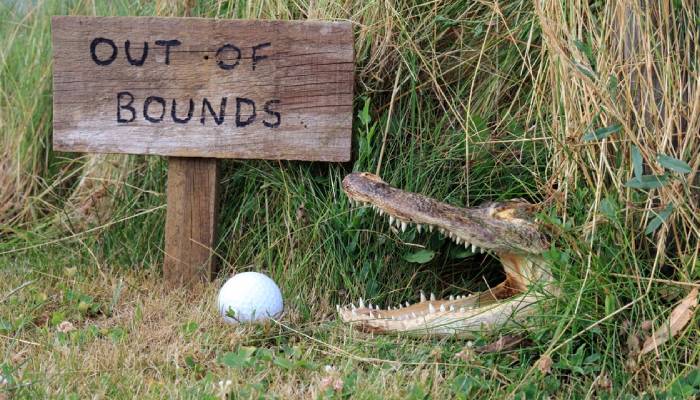
Golf has a lot of rules and we don’t always want to follow all of them. You don’t want to be the party pooper and ruin all the fun. We get it. But what if there was a way you could exercise good golf safety without being a stickler for the rules? Even the thickest skulls can be seriously hurt by a golf ball hitting them in the back of the head. Golf safety is a no-brainer (no pun intended).
To be safe both on and off the course, all it takes is a little bit of self-awareness and some easy-to-follow steps to ensure you won’t be struck by lightning, or an errant ball. In this article, we’re going to look at 8 simple ways to keep yourself (and others around you) safe, and your body in good working order, so you can enjoy more days in the sun and fewer days on a hospital bed.
Why so many rules?
Even for those of us who try to abide by the rules at all times, it can be difficult keeping track of them:
- Don’t swim in the ponds.
- Don’t eat the sand.
- Don’t pet the gators.
- Don’t drink and drive the golf carts.
- Don’t get wreckless when you see lightning.
The list goes on...

But think about everything you’re doing to improve your physical fitness and overall health: you eat healthy, warm up before teeing off, and stretch regularly to help prevent injuries. You don’t want to risk all of that hard work by making one poor decision.
Life doesn’t have to be boring! You can still have fun AND avoid the gators. You can experience all of the benefits of being safe without also being boring.
8 Golf Safety Rules
We’ve broken down golf safety to 8 primary focus points:
1. Warm Up
Whether you’re a professional golfer or you just entered retirement with plenty of time to golf, we all need to warm up before hitting the course. If your body is too tense, you risk injuring yourself -- injuries that can prevent you from enjoying a relaxing day on the course with your friends. Help try and avoid injuries by taking 5-10 minutes to warm up before tee time.
2. Stay Hydrated
All of that walking in the sun can really take its toll on your body. By the time you're thirsty, it's too late. You’re dehydrated. When you get really dehydrated you can develop headaches, become delirious and feel sick to your stomach -- some of the symptoms of heat stroke. After a certain point, your body will start to struggle with even the most basic things like walking.
Drink plenty of water before tee time (pre-hydration) and throughout the round. You’ll feel better on the course and you won’t feel as fatigued the next day.
3. Dress for the Expected Weather
Whether it’s the rain, sun, wind or snow, dress for the expected weather. On sunny days, wear a hat and use sun protection. On colder days, bring an extra jacket if you think you’ll get chilly later on. Footwear is important too, especially on rainy days, or if you’ll be out early in the morning when the dew hasn’t yet evaporated. You don’t want to risk pulling your back or spraining your ankle because you slipped on wet grass. Golf shoes with spikes (yes...spikes are back) great for keeping you on your toes at all times.
4. Keep Your Body Mobile
This one is for all of you golf cart users: keep your body mobile throughout the day. If you’re going to be driving around the course instead of walking, those pregame stretches become all the more critical. Keep the blood flowing and your butt off of that golf cart seat!
5. Maintain a Safe Distance from Other Golfers
Golf balls can either be your friend or your enemy. When they hit you in the face after gaining speed over a 200 yards drive, they tend to be your enemy. Maintain a safe distance from the group in front of you. If the group behind you is playing too close for comfort, let them play through.
6. Yell “Fore!”
This word has an interesting history. Golf historians believe it was first used in the early 19th century to refer to “forecaddies.” Because golf balls were so expensive, to reduce the number of lost balls, golfers would use forecaddies to go and stand where the golf ball might land, helping them keep track of each shot. Shouting “fore!” after each shot was used as a sort of warning for the forecaddies. Nowadays, it has morphed into a warning call for other golfers after a bad hook or slice. Hopefully, you’ll be using the term sparingly when you play, but if you do have a few bad shots and there are other golfers in your vicinity, shout it out loud.
7. Less Is More When Exercising
This one is for all of you diligent golfers out there, who know how valuable it is to exercise regularly. However, if you’re just getting started, be careful to not do too much at once. It’s better to do fewer exercises while maintaining proper form than it is to go full speed or strength train too hard. To see some golf-specific exercises developed by our golf coaches with over half a century of experience between them, check out the streaming golf fitness video library at Hit It Great.
8. Use a Golf Cart If You Struggle to Hold The Bag
If you have shoulder or lower back issues, then carrying a heavy golf club bag for 5 hours might not be the best idea. A good push cart can allow you to still enjoy walking with your clubs while giving your body some rest from carrying them.
Most of these golf safety tips pertain to simply being aware of your surroundings and listening to your body. If your shoulder is giving you issues, don’t ignore it and carry a golf bag around for 5 hours.
When it comes to your golf fitness, just don’t overdo things. If you’re serious about getting better at golf and having better health in general, find yourself a training center that specializes in golf fitness. For those of you in the Jupiter, Florida area, stop by train where the pros train. For those of you not in the area, you can still enjoy the benefits of world-class golf instruction by some of the best trainers in the world with our online golf fitness programs and workout videos you can do in your own living room. With minimal equipment needed to get started, these exercises are perfect for anyone looking to avoid spending a small fortune on expensive, specialized workout equipment.
© 2020 joeydgolf.com


